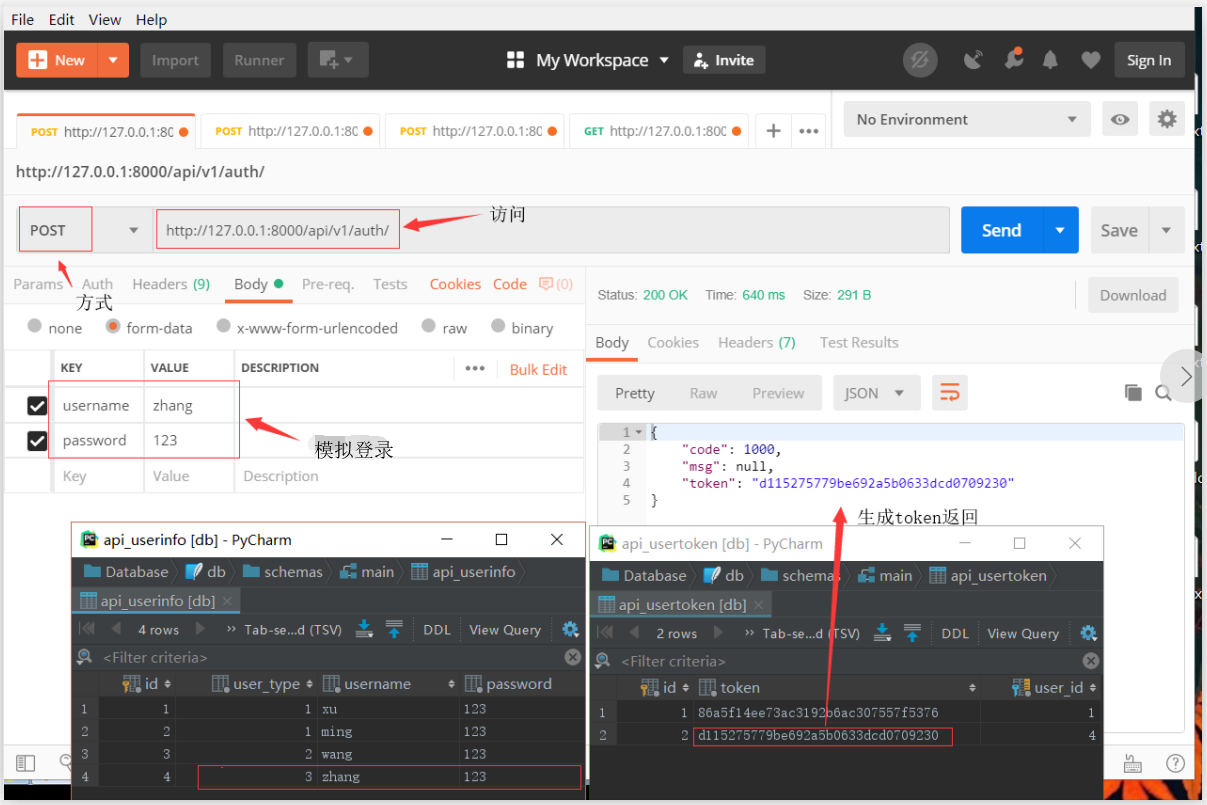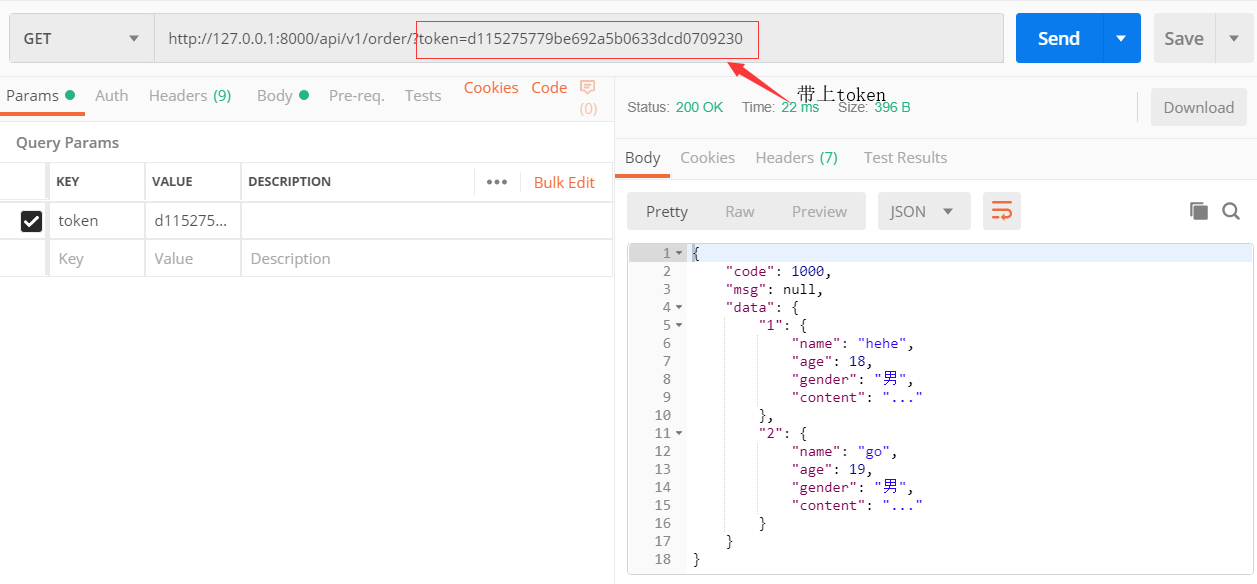一认证
我们可以想想,我们要访问一个页面,需不需要对其进行认证,希望进入页面的时候看到哪些内容,一般是根据用户的不同而不同
首先,我们先设计一个表,如何知道对方通过了验证,我们可以考虑给其加一个token,并且每个人都有不同的权限(大小)
#models.py from django.db import models class UserInfo(models.Model): user_type_choices=( (1,'普通用户'), (2,'VIP'), (3,"SVIP") ) user_type=models.IntegerField(choices=user_type_choices) username=models.CharField(max_length=32,unique=True) password=models.CharField(max_length=32) class UserToken(models.Model): user=models.OneToOneField(to='UserInfo') #默认就是UserInfo表的id token=models.CharField(max_length=64)
其次,需要设计token,token一般是一长串字符串,我们可以使用md5对其进行转化
#views.py
def md5(user): import hashlib,time ctime=str(time.time()) m=hashlib.md5(bytes(user,encoding='utf-8')) #使用bytes方法直接让str变成bytes m.update(bytes(ctime,encoding='utf-8')) return m.hexdigest()
设计验证方法
#views.py
from rest_framework.views import exceptions
from api import models
from rest_framework.authentication import BaseAuthentication
#BaseAuthentication类强制要求重写 authenticate函数,要不然抛出异常 .authenticate() must be overridden
class Auth_yanzheng(BaseAuthentication): def authenticate(self, request): token = request._request.GET.get('token') token_obj = models.UserToken.objects.filter(token=token).first() if not token_obj: raise exceptions.AuthenticationFailed('用户认证失败') # 在rest framework内部将两个字段赋值给request,以供后续操作使用 return (token_obj.user, token_obj) #返回元组 def authenticate_header(self, request): #这个要写要不然报错 pass
token从哪里获得?当然是用户登录的时候
#views.py
from rest_framework.views import APIView
from django.http import JsonResponse
class AuthView(APIView): #根据用户登录,找出token,有就更新,没有就新建
def post(self,request,*args,**kwargs): ret={'code':1000,'msg':None} try: user=request._request.POST.get('username') pwd=request._request.POST.get('password') obj=models.UserInfo.objects.filter(username=user,password=pwd).first() if not obj: ret['code']=1001 ret['msg']='用户名或密码错误' token=md5(user) models.UserToken.objects.update_or_create(user=obj,defaults={'token':token}) #注意update_or_create方法 ret['token']=token except Exception as e: print(e) ret['code']=1002 ret['msg']='请求异常' return JsonResponse(ret)
接着我们设计一下url
url(r'^api/v1/auth/$',views.AuthView.as_view()),
下面通过postman来实现这一过程,能再数据库里面找到用户信息,则给用户加上一个token

下面,我们来设计另外一个函数,用上我们的认证
#urls.py
url(r'^api/v1/auth/$',views.AuthView.as_view()),
url(r'^api/v1/order/$',views.OrderView.as_view()),
#views.py
ORDER_DICT={
1:{
'name':"hehe",
'age':18,
'gender':'男',
'content':"..."
},
2: {
'name': "go",
'age': 19,
'gender': '男',
'content': "..."
}
}
class OrderView(APIView): authentication_classes = [Auth_yanzheng] def get(self,request,*args,**kwargs): # token=request._request.GET.get('token') # if not token: # return HttpResponse('用户未登录') ret={'code':1000,'msg':None,'data':None} try: ret['data']=ORDER_DICT #ORDER_DICT是我们给成功认证的用户看的东西 except Exception as e: pass return JsonResponse(ret)

总结流程:(单一考虑认证)
首先,经过urls,urls里面执行的是 as_view方法,找as_view方法,我们没写,---》找到父类APIview,APIview继承了view,view里面的as_view方法返回的是dispatch APIview里面的dispatch方法,执行initialize_request函数,它对request进行封装 authenticators=self.get_authenticators(), 函数get_authenticators里面,遍历authentication_classes ---》return [auth() for auth in self.authentication_classes] 接着再全局变量里面找 authentication_classes = api_settings.DEFAULT_AUTHENTICATION_CLASSES,没有就找到局部
回到APIview执行initial函数--》执行 self.perform_authentication(request),函数perform_authentication返回 request.user
request来自哪里呢,回到封装request的地方,发现request是一个类,找到它的user方法,里面执行 self._authenticate(),_authenticate里面循环类的对象,执行对象的authenticate方法
authenticate就是我们自己写的方法
下面看_authenticate
def _authenticate(self): """ Attempt to authenticate the request using each authentication instance in turn. """ for authenticator in self.authenticators: try: user_auth_tuple = authenticator.authenticate(self) #接收我们给的值 except exceptions.APIException: self._not_authenticated() raise if user_auth_tuple is not None: self._authenticator = authenticator self.user, self.auth = user_auth_tuple #分别赋值给user,auth return self._not_authenticated()
def _not_authenticated(self): """ Set authenticator, user & authtoken representing an unauthenticated request. Defaults are None, AnonymousUser & None. """ self._authenticator = None if api_settings.UNAUTHENTICATED_USER: self.user = api_settings.UNAUTHENTICATED_USER() #如果经过了,什么用户都没有的情况下,返回默认值 AnonymousUser else: self.user = None if api_settings.UNAUTHENTICATED_TOKEN: self.auth = api_settings.UNAUTHENTICATED_TOKEN() else: self.auth = None



